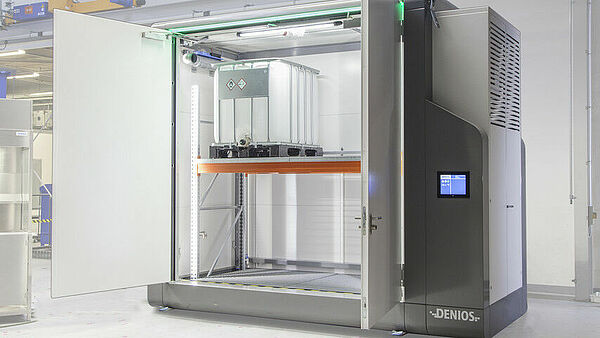An intelligent storage and extraction of hazardous materials protects the environment and the health of the employees. In practice there is a lack of solutions that detect potential damages in hazardous materials warehouse in advance. For the first time, scientists from the Institute Industrial IT (inIT) of OWL-University realized together with DENIOS AG and partners from industry and science a sensor based early warning system for hazardous materials with linked filling unit. The project’s name IGel means “Intelligent autonomous hazardous materials warehouse with sensor based Condition-Monitoring”.
“For the first time in the range of hazardous storage technology, we could implement intelligently connected components of automation technology and sensor technology into a storage system”, so Professor Stefan Witte and Professor Volker Lohweg (Board Institute Industrial IT). The aim of the research project was the development and implementation of an information fusion system for hazardous materials warehouses and its automatic control or reaction. The result after three years of research work: an intelligent autonomous machine with sensor-based damage detection”, says Witte.
The scientists from Lemgo selected suitable sensors for the developed demonstrator and developed a sensor fusion and networking-concept. This includes a constantly gathering of information via sensors on the basis of sensor fusion. Is the normal condition determined in the system, for example a certain temperature range, the state of health and errors are detected automatically, an optimization is also executed. An algorithm detects the overall condition of the warehouse. It automatically controls target-orientated countermeasures, like the close of the ventilation or fire protection flaps, so that the warehouse can react independently to potential damage or danger events. In addition to the automatic detection of dangerous situations, the developed algorithms make it possible to detect defect sensors.
“The challenges of the project IGel were to develop an intelligent early warning system that quickly detects damaging events, analyzes or identifies the threat and automatically initiates countermeasures”, says Lohweg. This system is brought together with an automated withdrawal and dosing station, that was developed at Fraunhofer IPT, one of the project partners.
The project goals of “it’s OWL-IGel” were the development of an intelligent autonomous hazardous materials warehouse with sensor based condition monitoring as well as the development of an intelligent autonomous machine for hazardous materials that similar to a drinks machine make possible a safe removal and dose of liquids. “We realized a functional intelligent hazardous materials warehouse. The next logical step would be the further development to series production. The project offers great potential, like for example the realization of an automatic warehousing or warehouse management”, resumes Witte confidentially.
About it’s OWL-IGel:
The research project was funded for three years in the leading-edged-cluster „it’s OWL – intelligent technical systems OstWestfalenLippe“ by the Federal Ministry of Education and Research (BMBF). Aside from the Institute Industrial IT (inIT) of OWL-University, project partners were: DENIOS AG, OWITA GmbH and Fraunhofer IPT (Projektgruppe Entwurfstechnik Mechatronik). Under the roof of CENTRUM INDUSTRIAL IT (CIIT) the inIT is doing research for the factory of the future.




